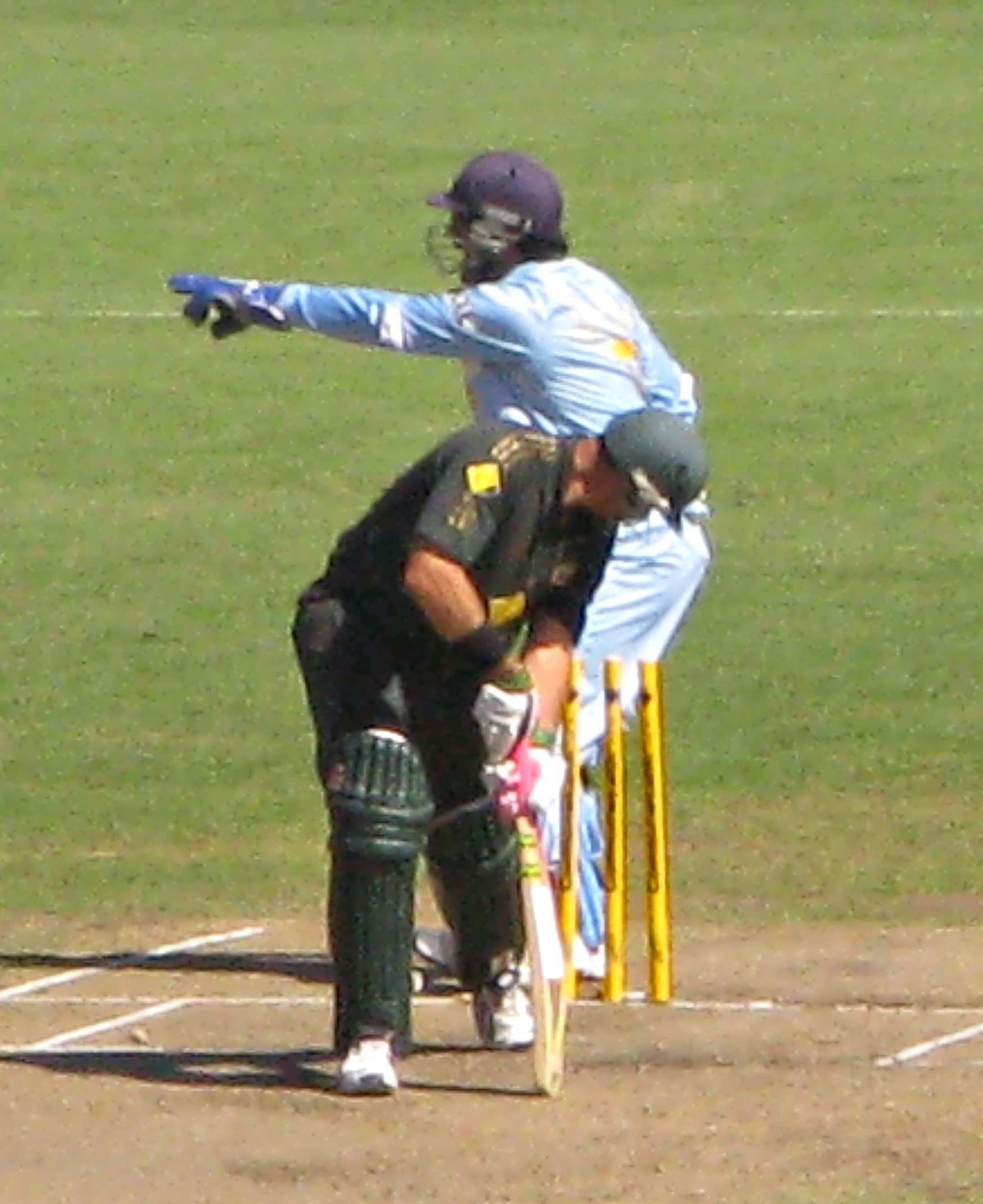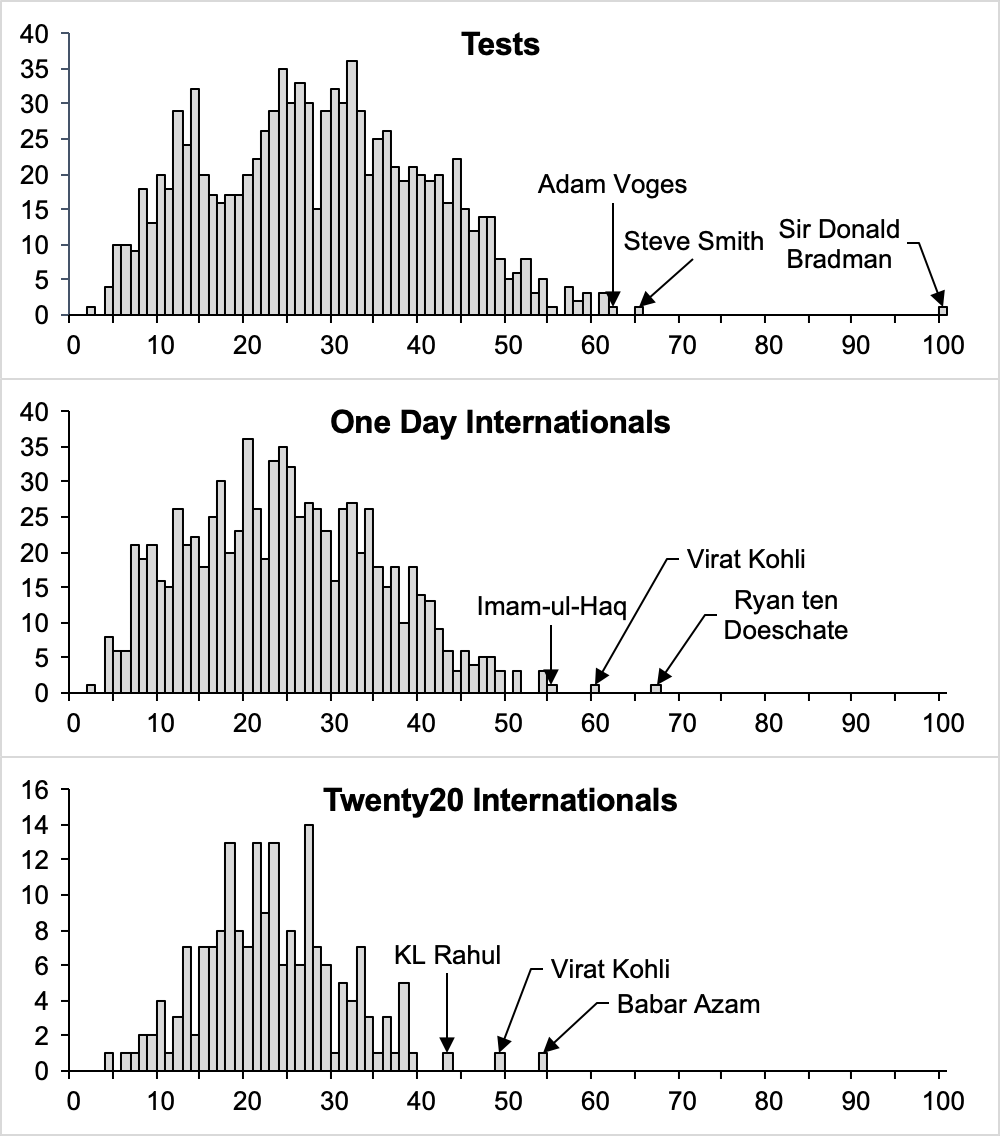|
Thomas Blake (cricketer)
Thomas Gage Blake (10 April 1805 – 1895) was an English cricketer. Blake's batting style is unknown, though it is known he fielded as a wicket-keeper. He was born at Midhurst, Sussex. Blake made his first-class debut for an England XI against Surrey in 1829. The following season he made two first-class appearances for Suffolk, against the Marylebone Cricket Club at Lord's, and against the same opposition at Field Lane, Bury St Edmunds. In that same season he made two first-class appearances for Sussex, with both appearances coming against Surrey at The Burys, Godalming and Midhurst Cricket Ground. In 1832, he made two first-class appearances for the Marylebone Cricket Club, with both appearances coming against the Cambridge Town Club at Chatteris Cricket Ground and Parker's Piece, Cambridge. In total, Blake made seven first-class appearances, scoring 102 runs at an average of 9.27, with a high score of 26. Behind the stumps he took 3 catches and made 5 stumpings. ... [...More Info...] [...Related Items...] OR: [Wikipedia] [Google] [Baidu] |
Midhurst
Midhurst () is a market town, parish and civil parish in West Sussex, England. It lies on the River Rother inland from the English Channel, and north of the county town of Chichester. The name Midhurst was first recorded in 1186 as ''Middeherst'', meaning "Middle wooded hill", or "(place) among the wooded hills". It derives from the Old English words ''midd'' (adjective) or ''mid'' (preposition), meaning "in the middle", plus ''hyrst'', "a wooded hill". The Norman St. Ann's Castle dates from about 1120, although the foundations are all that can now be seen. The castle, the parish church of St. Mary Magdalene and St. Denis, together with South Pond, the former fish-pond for the castle, are the only three structures left from this early period. The parish church is the oldest building in Midhurst. Just across the River Rother, in the parish of Easebourne, is the ruin of the Tudor Cowdray House. Governance National The former Parliamentary Constituency of Midhurst i ... [...More Info...] [...Related Items...] OR: [Wikipedia] [Google] [Baidu] |
Cemetry Road
Cemetry Road was a cricket ground in Bury St Edmunds, Suffolk. The ground was known as Field Lane from 1826 to 1854 and was later known as the West Suffolk Cricket Ground. Today, the location of the ground would be along King's Road in Bury St Edmunds, with the stretch of the A1302 named Parkway bisecting the site. History The first recorded match on the ground was in 1827, when the Suffolk played the Marylebone Cricket Club. The ground held two first-class matches, the first in 1830 when Suffolk played the Marylebone Cricket Club and in 1847 when Suffolk played the same opposition. After many decades of use by Suffolk, the ground hosted its first Minor Counties Championship match in 1904 when Suffolk played Cambridgeshire. From 1902 to 1914, the ground hosted eight Minor Counties Championship matches, the last which saw Suffolk play Lincolnshire. It switched from being a cricket ground to a football ground during World War II, with it being the home ground of Bury Town F.C ... [...More Info...] [...Related Items...] OR: [Wikipedia] [Google] [Baidu] |
People From Midhurst
A person ( : people) is a being that has certain capacities or attributes such as reason, morality, consciousness or self-consciousness, and being a part of a culturally established form of social relations such as kinship, ownership of property, or legal responsibility. The defining features of personhood and, consequently, what makes a person count as a person, differ widely among cultures and contexts. In addition to the question of personhood, of what makes a being count as a person to begin with, there are further questions about personal identity and self: both about what makes any particular person that particular person instead of another, and about what makes a person at one time the same person as they were or will be at another time despite any intervening changes. The plural form "people" is often used to refer to an entire nation or ethnic group (as in "a people"), and this was the original meaning of the word; it subsequently acquired its use as a plural form of p ... [...More Info...] [...Related Items...] OR: [Wikipedia] [Google] [Baidu] |
1895 Deaths
Events January–March * January 5 – Dreyfus affair: French officer Alfred Dreyfus is stripped of his army rank, and sentenced to life imprisonment on Devil's Island. * January 12 – The National Trust for Places of Historic Interest or Natural Beauty is founded in England by Octavia Hill, Robert Hunter and Canon Hardwicke Rawnsley. * January 13 – First Italo-Ethiopian War: Battle of Coatit – Italian forces defeat the Ethiopians. * January 17 – Félix Faure is elected President of the French Republic, after the resignation of Jean Casimir-Perier. * February 9 – Mintonette, later known as volleyball, is created by William G. Morgan at Holyoke, Massachusetts. * February 11 – The lowest ever UK temperature of is recorded at Braemar, in Aberdeenshire. This record is equalled in 1982, and again in 1995. * February 14 – Oscar Wilde's last play, the comedy ''The Importance of Being Earnest'', is first shown at St James's The ... [...More Info...] [...Related Items...] OR: [Wikipedia] [Google] [Baidu] |
1805 Births
Eighteen or 18 may refer to: * 18 (number), the natural number following 17 and preceding 19 * one of the years 18 BC, AD 18, 1918, 2018 Film, television and entertainment * ''18'' (film), a 1993 Taiwanese experimental film based on the short story ''God's Dice'' * ''Eighteen'' (film), a 2005 Canadian dramatic feature film * 18 (British Board of Film Classification), a film rating in the United Kingdom, also used in Ireland by the Irish Film Classification Office * 18 (''Dragon Ball''), a character in the ''Dragon Ball'' franchise * "Eighteen", a 2006 episode of the animated television series '' 12 oz. Mouse'' Music Albums * ''18'' (Moby album), 2002 * ''18'' (Nana Kitade album), 2005 * '' 18...'', 2009 debut album by G.E.M. Songs * "18" (5 Seconds of Summer song), from their 2014 eponymous debut album * "18" (One Direction song), from their 2014 studio album ''Four'' * "18", by Anarbor from their 2013 studio album ''Burnout'' * " I'm Eighteen", by Alice Cooper commonly ... [...More Info...] [...Related Items...] OR: [Wikipedia] [Google] [Baidu] |
ESPNcricinfo
ESPN cricinfo (formerly known as Cricinfo or CricInfo) is a sports news website exclusively for the game of cricket. The site features news, articles, live coverage of cricket matches (including liveblogs and scorecards), and ''StatsGuru'', a database of historical matches and players from the 18th century to the present. , Sambit Bal was the editor. The site, originally conceived in a pre-World Wide Web form in 1993 by Simon King, was acquired in 2002 by the Wisden Grouppublishers of several notable cricket magazines and the Wisden Cricketers' Almanack. As part of an eventual breakup of the Wisden Group, it was sold to ESPN, jointly owned by The Walt Disney Company and Hearst Corporation, in 2007. History CricInfo was launched on 15 March 1993 by Simon King, a British researcher at the University of Minnesota. It grew with help from students and researchers at universities around the world. Contrary to some reports, Badri Seshadri, who was very instrumental in CricInfo's ... [...More Info...] [...Related Items...] OR: [Wikipedia] [Google] [Baidu] |
Stumping
Stumped is a method of dismissing a batsman in cricket, which involves the wicket-keeper putting down the wicket while the batsman is out of his ground. (The batsman leaves his ground when he has moved down the pitch beyond the popping crease, usually in an attempt to hit the ball). The action of stumping can only be performed by a wicket-keeper, and can only occur from a legitimate delivery (i.e. not a no-ball), while the batsman is not attempting a run; it is a special case of a run out. Being "out of his ground" is defined as not having any part of the batsman's body or his bat touching the ground behind the crease – i.e., if his bat is slightly elevated from the floor despite being behind the crease, or if his foot is on the crease line itself but not completely across it and touching the ground behind it, then he would be considered out (if stumped). One of the fielding team (such as the wicket-keeper himself) must appeal for the wicket by asking the umpire. The app ... [...More Info...] [...Related Items...] OR: [Wikipedia] [Google] [Baidu] |
Catch (cricket)
Caught is a method of dismissing a batsman in cricket. A batsman is out caught if the batsman hits the ball, from a legitimate delivery, with the bat, and the ball is caught by the bowler or a fielder before it hits the ground. If the ball hits the stumps after hitting the wicket-keeper, If the wicket-keeper fails to do this, the delivery is a "no ball", and the batsman cannot be stumped (nor run out, unless he attempts to run to the other wicket.) If the catch taken by the wicket-keeper,then informally it is known as caught behind or caught at the wicket. A catch by the bowler is known as caught and bowled. This has nothing to do with the dismissal bowled but is rather a shorthand for saying the catcher and bowler are the same player. (The scorecard annotation is usually ''c. and b.'' or ''c&b'' followed by the bowler's name.) Caught is the most common method of dismissal at higher levels of competition, accounting for 36,190 Test match dismissals between 1877 and 2012, ... [...More Info...] [...Related Items...] OR: [Wikipedia] [Google] [Baidu] |
Stumps
In cricket, the stumps are the three vertical posts that support the bails and form the wicket. '' Stumping'' or ''being stumped'' is a method of dismissing a batsman. The umpire ''calling stumps'' means the play is over for the day. Part of the wicket The stumps are three vertical posts which support two bails. The stumps and bails are usually made of wood, most commonly ash, and together form a wicket at each end of the pitch. The overall width of each wicket is 9 inches (22.9 cm). Each stump is 28 inches (71.1 cm) tall with maximum and minimum diameters of 1 inches (3.81 cm) and 1 inches (3.49 cm). They have a spike at one end for inserting into the ground, and the other end has a U-shaped 'through groove' to provide a resting place for the bails. In junior cricket the items have lesser dimensions. Each stump is referred to by a specific name: * Off stump is the stump on the off side of the wicket (the same side as the batsman's bat). * M ... [...More Info...] [...Related Items...] OR: [Wikipedia] [Google] [Baidu] |
Batting Average (cricket)
In cricket, a player's batting average is the total number of runs they have scored divided by the number of times they have been out, usually given to two decimal places. Since the number of runs a player scores and how often they get out are primarily measures of their own playing ability, and largely independent of their teammates, batting average is a good metric for an individual player's skill as a batter (although the practice of drawing comparisons between players on this basis is not without criticism). The number is also simple to interpret intuitively. If all the batter's innings were completed (i.e. they were out every innings), this is the average number of runs they score per innings. If they did not complete all their innings (i.e. some innings they finished not out), this number is an estimate of the unknown average number of runs they score per innings. Each player normally has several batting averages, with a different figure calculated for each type of matc ... [...More Info...] [...Related Items...] OR: [Wikipedia] [Google] [Baidu] |
Parker's Piece
Parker's Piece is a flat and roughly square green common located near the centre of Cambridge, England, regarded by some as the birthplace of the rules of association football. The two main walking and cycling paths across it run diagonally, and the single lamp-post at the junction is colloquially known as Reality Checkpoint. The area is bounded by Park Terrace, Parkside, Gonville Place, and Regent Terrace. The Cambridge University Football Club Laws were first used on Parker's Piece and adopted by the Football Association in 1863. "They embrace the true principles of the game, with the greatest simplicity" (E. C. Morley, F.A. Hon. Sec. 1863). 'The Cambridge Rules appear to be the most desirable for the Association to adopt' (C. W. Alcock 1863, FA committee member and founder of the FA Cup). The grass is mown and the area is known today chiefly as a spot for picnics and games of football and cricket, and serves as the games field for nearby Parkside Community College. Fair ... [...More Info...] [...Related Items...] OR: [Wikipedia] [Google] [Baidu] |
Chatteris Cricket Ground
Chatteris Cricket Ground is a cricket ground in Chatteris, Cambridgeshire. The first recorded match on the ground was in 1832, when Cambridge Town Club played the Marylebone Cricket Club in the ground's only first-class match. The ground was first used for Minor Counties Championship cricket when Cambridgeshire played Lincolnshire in 1967. From 1967 to 1971, the ground hosted 4 Minor Counties Championship matches, the last of which saw Cambridgeshire play Bedfordshire Chatteris CC was formed in 1879 and it is uncertain if the field used in 1832 is the same one currently used by the town club in Wenny Road.Chatteris CC Play-cricket.com References External linksChatteris Cricket Groundon CricketArchiveon Cricinfo ESPN cricinfo (formerly known as Cricinfo or CricInfo) is a sports news website exclusively for the game of cricket. The site features news, articles, live coverage of cricket matches (including liveblogs and scorecards), and ''StatsGuru'', a d ... C ... [...More Info...] [...Related Items...] OR: [Wikipedia] [Google] [Baidu] |
_1938.jpg)






